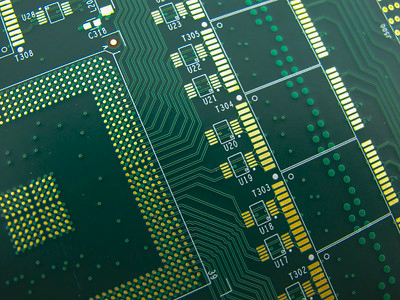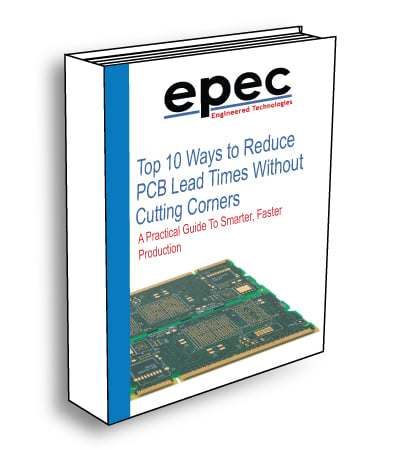HDI Boards – High Density Interconnect
HDI boards, one of the fastest growing technologies in PCBs, are now available at Epec. HDI Boards contain blind and/or buried vias and often contain microvias of .006 or less in diameter. They have a higher circuitry density than traditional circuit boards.
There are 6 different types of HDI boards, through vias from surface to surface, with buried vias and through vias, two or more HDI layer with through vias, passive substrate with no electrical connection, coreless construction using layer pairs and alternate constructions of coreless constructions using layer pairs. Here is everything you need to know in regards to Designing HDI PCBs: The Requirements, Advantages and Complexities.

Printed Circuit Board Using HDI Technology
Consumer Driven Technology
The via-in-pad process supports more technology on fewer layers, proving that bigger is not always better. Since the late 1980's we have seen video cameras using cartridges the size of a novel, shrink to fit in the palm of your hand. Mobile computing and working from home pushed technology further to make computers faster and lighter, allowing the consumer to work remotely from anywhere.
HDI Technology is the leading reason for these transformations. Products do more, weigh less and are physically smaller. Specialty equipment, mini-components and thinner materials have allowed for electronics to shrink in size while expanding technology, quality and speed.
Key HDI Benefits
As consumer demands change, so must technology. By using HDI technology, designers now have the option to place more components on both sides of the raw PCB. Multiple via processes, including via in pad and blind via technology, allow designers more PCB real estate to place components that are smaller even closer together. Decreased component size and pitch allow for more I/O in smaller geometries. This means faster transmission of signals and a significant reduction in signal loss and crossing delays.
Via in Pad Process
Inspiration from surface mount technologies from the late 1980's has pushed the limits with BGA's, COB and CSP into smaller square surface inches. The via in pad process allows for vias to be placed within the surface of the flat lands. The via is plated and filled with either conductive or non-conductive epoxy then capped and plated over, making it virtually invisible.
Sounds simple but there is an average of eight additional steps to complete this unique process. Specialty equipment and trained technicians follow the process closely to achieve the perfect hidden via.
Via Fill Types
There are many different types of via fill material: non conductive epoxy, conductive epoxy, copper filled, silver filled and electrochemical plating. These all result in a via buried within a flat land that will completely solders as normal lands. Vias and microvias are drilled, blind or buried, filled then plated and hidden beneath SMT lands. Processing vias of this type requires special equipment and is time consuming. The multiple drill cycles and controlled depth drilling adds to process time.
Cost Effective HDI
While some consumer products shrink down in size, quality remains the most important factor for the consumer second to price. Using HDI technology during design, it is possible to reduce an 8 layer through-hole PCB to a 4 layer HDI microvia technology packed PCB. The wiring capabilities of a well-designed HDI 4 layer PCB can achieve the same or better functions as that of a standard 8 layer PCB.
Although the microvia process increases the cost of the HDI PCB, the proper design and reduction in layer count reduces cost in material square inches and layer count more significantly.
Building Non-Conventional HDI Boards
Successful manufacturing of HDI PCBs requires special equipment and processes such as laser drills, plugging, laser direct imaging and sequential lamination cycles. HDI boards have thinner lines, tighter spacing and tighter annular ring, and use thinner specialty materials. In order to successfully produce this type of board, it requires additional time and a significant investment in manufacturing processes and equipment.
Laser Drill Technology
Drilling the smallest of micro-vias allows for more technology on the board's surface. Using a beam of light 20 microns (1 Mil) in diameter, this high influence beam can cut through metal and glass creating the tiny via hole. New products exist such as uniform glass materials that are a low loss laminate and low dielectric constant. These materials have higher heat resistance for lead free assembly and allow for the smaller holes to be used.
Lamination & Materials For HDI Boards
Advanced multilayer technology allows for designers to sequentially add additional pairs of layers to form a multilayer PCB. The use of a laser drill to produce holes in the internal layers allows for plating, imaging and etching prior to pressing. This added process is known as sequential build up. SBU fabrication uses solid filled vias allowing for better thermal management, a stronger inter connect and increasing the board's reliability.
Resin coated copper was developed specifically to aide with poor hole quality, longer drill times and to allow for thinner PCBs. RCC has an ultra-low profile and ultra-thin copper foil that is anchored with minuscule nodules to the surface. This material is chemically treated and primed for the thinnest and finest line and spacing technology.
The application of dry resist to the laminate still uses heated roll method to apply the resist to core material. This older technology process, it is now recommended to preheat the material to a desired temperature prior to the lamination process for HDI printed circuit boards. The preheating of the material allows for better a steady application of the dry resist to the surface of the laminate, pulling less heat away from the hot rolls and allowing for consistent stable exit temperatures of the laminated product. Consistent entrance and exit temperatures lead to less air entrapment beneath the film; this is critical to the reproduction of fine lines and spacing.
LDI & Contact Imagery
Imaging finer lines than ever before and using semiconductor Class 100 Clean rooms to process these HDI parts is costly but necessary. Finer lines, spacing and annular ring requires much tighter controls. With use of finer lines, touch up rework or repair becomes an impossible task. Photo tool quality, laminate prep and imaging parameters are necessary for successful process. Using a clean room atmosphere decreases defects. Dry film resist is still the number one process for all technology boards.
Contact imaging is still widely used due to cost of laser direct imaging; however, LDI is a far better option for such fine lines and spacing. Currently most factories still use contact imaging in a SC100 room. As the demand expands, so does the need for laser drilling and laser direct imaging. All of Epec's HDI production facilities use the latest in technology equipment to produce this advanced PCB.
Discover more here, PCB Fine Lines and Spaces | Hi-Tech HDI Circuit Board Manufacturing.
Products such as cameras, laptops, scanners and cell phones will continue to push technology to smaller and lighter requirements for the consumer's daily use. In 1992, the average cell phone weighed 220-250 grams and was strictly for making phone calls; we now call, text, surf the net, play our favorite songs or games and take pictures and videos on one tiny device weighing 151grams. Our changing culture will continue to drive HDI technology and Epec will be here to continue to support our customer needs.
Watch Our Video
Ensuring Consistent Hole Plating when Dealing with Aspect Ratios
Unlock the Future of PCB Design with Advanced HDI Technology
Experience smaller, faster, and more efficient circuit boards without compromising quality. Don't get left behind. Tap into Epec's HDI expertise today.
Request a Quote Request Design Support Request More Information



